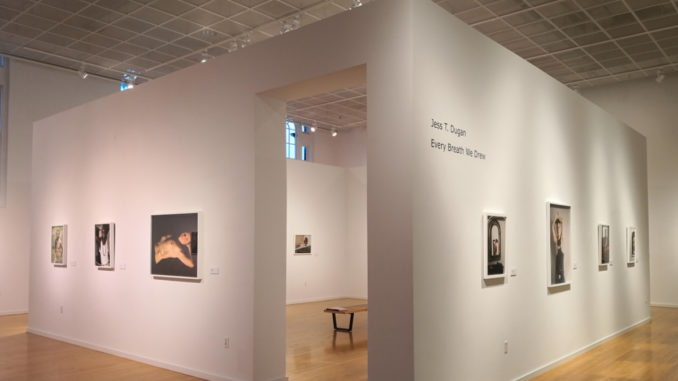
In the heart of Ophelia Parrish Building sits the University Art Gallery. Around this time of year it would usually be bustling with faculty and students snacking and socializing while admiring the art. However, now the room stands silent, only the art and stale air occupying the space.
Because of the COVID-19 pandemic, the University Art Gallery cancelled its usual openings and moved curator talks online, yet these changes have not stunted the gallery’s educational experience.
Heidi Cook, director of the University Art Gallery, said the mission of the art gallery is to serve the art department, the University campus community, and the larger Kirksville and Northeast Missouri community. About half of the gallery’s annual schedule is dedicated to showing student and faculty art, including juried student exhibitions and senior capstone exhibitions. The other half of the year, the gallery directory, in conjunction with the art faculty, invites practicing artists and curates historically significant shows with loaned works from local and national collections.
“A fundamental belief of any art gallery or museum is that seeing original works of art and design in person is an invaluable experience to which everyone should have access,” Cook said. “You get a sense of scale, materiality and an artist’s hand that is just not possible to replicate through digital images.”
She said as an art gallery that is part of a university, it also has a strong commitment to diversity and inclusion.
Cook said the University Art Gallery is a rare space for Northeast Missouri where contemporary and sometimes difficult issues are regularly addressed. Cook explained that in recent years, topics addressed through artwork in the gallery have included the environment, immigration, disability, war, health, income inequality and race.
Cook said she was excited for the University Gallery to have Jess Dugan exhibit her portraits of individuals who portray a broad range of gender and sexual identities.
“All of that plays a role,” Cook said. “Art has this ability to help us digest our own experiences as well as get a sense of what other people experience, other ways of being in the world than our own.”
The gallery wanted to uphold that same mission while keeping patrons safe from COVID-19. Cook said the gallery now has a maximum occupancy of 12, unless instructors make appointments. Masks and social distancing are also required throughout the gallery.
For the exhibit entitled “Wandering Spirit: African Wax Prints,” put together by the Mid-America Arts Alliance and Gifty Benson, the curator of the collection of African wax cloths. Rather than having an in-person opening with lots of publicity, snacks, and attendance from on and off-campus, the gallery had a soft opening and an online curator talk.
Cook said 48 people attended the live talk on Zoom.
“It is sad [to have a soft opening] because those openings of the exhibitions are not only social events for the art department but you get to connect with the broader University community and people from the larger community who are interested in the arts,” Cook said. “It is sad when we can’t have those because then we can’t reinforce those connections we make within and outside of the University.”
The gallery is a learning experience not only for the University community, but for the local community as well.
Cook said every year students come from local schools on field trips to the gallery. She also said there is a large community of African immigrants in Kirksville, many of which are from the Democratic Republic of Congo, and it is important to increase knowledge of other cultures in our community when we can.
Haley Koch, graduate teaching research assistant in the education department’s outreach branch, has been working all semester creating a curriculum for local classes about the African wax cloth exhibit.
Koch said she has previously taught a JINS class and a freshman self and society seminar. Now she plans to teach a 5th-grade class in Macon, art classes at Ray Miller Elementary, and English-second language students at a local middle and high school.
“I initially planned these lessons in person, then had to rearrange a lot of things and how to present and implement an activity,” Koch said. “In general, I have had to think about a lot of other scenarios than just face to face.”
Because of COVID-19 precautions, the lessons have been moved to Zoom.
In the curriculum, Koch said she plans to introduce the gallery, explain the African wax cloths, how the fabrics deal with the identity of West Africa and analyze 3-5 samples of fabrics with students. Koch is also planning an art activity for students to mimic the fabrics or create their own.
She said she plans to draw parallels between students’ own identities and West African identity and culture.
Koch said this project combines her passions and career goals, since her undergraduate degree is in art and her masters is in education.
“Personally, I have grown a lot in not only what it takes to develop a lesson plan and curriculum for different ages, abilities and grade levels, but also what it takes to develop all these into a virtual experience,” Koch said.
Koch also said she has learned a lot by looking at the fabrics, like how what people wear can create an identity.
Koch said she is still learning a lot about seeing what people view as art from western standards and challenging what we view as art, whether it be a painting on a wall or the clothes we wear.
